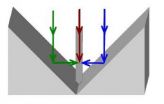(Press-News.org) AUGUSTA, Ga. – Daily sessions of whole-body vibration may combat prediabetes in adolescents, dramatically reducing inflammation, average blood glucose levels and symptoms such as frequent urination, researchers report.
In mice that mimic over-eating adolescents headed toward diabetes, 20 minutes of daily vibration for eight weeks restored a healthy balance of key pro- and anti-inflammatory mediators and was better than prescription drugs at reducing levels of hemoglobin A1c, the most accurate indicator of average blood glucose levels, said Dr. Jack C. Yu, Chief of the Section of Plastic and Reconstructive Surgery at the Medical College of Georgia at Georgia Health Sciences University.
In normal mice, just four days of vibration also dramatically improved the ability to manage a huge glucose surge similar to that following a high-calorie, high-fat meal. "It's a very good sign," said Yu. "If you eat a pound of sugar, your blood glucose will go up. If you are prediabetic, it will go up even more and take longer to come down."
Interestingly, vibration did not produce similar changes in older, normal mice, Yu told researchers at the Third World Congress of Plastic Surgeons of Chinese Descent.
"This is our model: the average American teenager who eats too much," said Yu, who regularly operates on obese and often prediabetic adolescent males who want their abnormally large breasts reduced. "The only way to burn fat is to exercise. We shake the bone for you rather than the body's muscle shaking it. This is a highly efficient way to fool the bone into thinking we are exercising."
It's also one way to deal with the reality that many individuals simply will not exercise regularly, he said.
Yu, also a craniofacial surgeon who studies bone formation, said while it's unclear exactly how vibration produces these desirable results, it seems linked to the impact of movement on bone health. Vibration mimics the motion bones experience during exercise when muscles are doing the work. The slight bending and unbending of bone triggers remodeling so it can stay strong. One result is production of osteocalcin, a protein essential to bone building, which also signals the pancreas to get ready for food. While this prehistoric relationship is tied to the hunt for food, it doesn't work so well in 21st century living where folks are moving too little and eating too much, Yu said. The constant demand can produce resistance to the insulin required to use glucose as energy.
Additionally, the body tends to hold onto fat for energy and survival, which researchers think is key to the chronic inflammation found in obesity-related type 2 diabetes. The fat itself produces inflammatory factors; the immune system also can misidentify fat as an infection, resulting in even more inflammation but, unfortunately, not eliminating the fat.
The bottom line is an unbalanced immune response: too many aggressors like the immune system SWAT team member Th17 and too few calming regulating factors like FoxP3. Researchers looked in the mouse blood and found vibration produced a 125-fold increase in immune system homeostasis and similar results in the kidney. This included positive movement in other players as well, such as a five-fold reduction in what Yu calls the "nuclear fuel," gammaH2AX, an indicator that something is attacking the body's DNA.
The animal model researchers used has a defect in the receptor for leptin, the satiety hormone, so the mice uncharacteristically overeat. Vibration also significantly reduced the mouse's diabetic symptoms of excessive thirst and diluted urine, resulting from excessive urination. The mice also seemed to like it, Yu said.
Next steps include learning more about how vibration produces such desirable results and large-scale clinical studies to see if they hold true in adolescents.
Prediabetics can avoid type 2 diabetes by making healthy diet changes and increasing physical activity, according to the American Diabetes Association.
Vibration technology was originally developed by the former Soviet Union to try to prevent muscle and bone wasting in cosmonauts. MCG researchers reported in the journal Bone in 2010 that daily whole body vibration may help minimize age-related bone density loss.
Yu and Biomedical Engineer Karl H. Wenger developed the whole-body vibrator used for the animal studies. Study coauthors include Wenger as well as GHSU's Drs. Babak Baban, Sun Hsieh, Mahmood Mozaffari and Mohamad Masoumy.
INFORMATION:
Daily vibration may combat prediabetes in youth
2012-10-20
ELSE PRESS RELEASES FROM THIS DATE:
Disk galaxies formed gradually, astronomers find from images, computer simulations, and spectra
2012-10-20
Spectroscopic observations of distant galaxies taken with the 10-meter telescopes at the W. M. Keck Observatory on Hawaii, when combined with images taken by the Hubble Space Telescope plus supercomputer simulations to help interpret the observations, together reveal a major surprise: that a standard assumption about the evolution of galaxies is not correct.
Astronomers had thought that disk galaxies (like our own Milky Way) had largely finished forming by about 8 billion years ago, as indicated by the rates at which stars are formed in the Universe. Therefore, many astronomers ...
Science reveals the power of a handshake
2012-10-20
New neuroscience research is confirming an old adage about the power of a handshake: strangers do form a better impression of those who proffer their hand in greeting.
A firm, friendly handshake has long been recommended in the business world as a way to make a good first impression, and the greeting is thought to date to ancient times as a way of showing a stranger you had no weapons. Now, a paper published online and for the December print issue of the Journal of Cognitive Neuroscience on a study of the neural correlates of a handshake is giving insight into just ...
Dartmouth researchers explore how the brain perceives direction and location
2012-10-20
The Who asked "who are you?" but Dartmouth neurobiologist Jeffrey Taube asks "where are you?" and "where are you going?" Taube is not asking philosophical or theological questions. Rather, he is investigating nerve cells in the brain that function in establishing one's location and direction.
Taube, a professor in the Department of Psychological and Brain Sciences, is using microelectrodes to record the activity of cells in a rat's brain that make possible spatial navigation—how the rat gets from one place to another—from "here" to "there." But before embarking to go ...
NASA sees extra-large, now extra-tropical storm Prapiroon fading
2012-10-20
Prapiroon is both extra-large and now extra-tropical in the western North Pacific Ocean. NASA's Terra satellite captured an image of the large storm after Prapiroon became extra-tropical.
The Moderate Resolution Imaging Spectroradiometer (MODIS) instrument aboard NASA's Terra satellite captured a visible image of Extra-tropical Storm Prapiroon on Oct. 19 at 01:15 UTC (Oct. 18, 9:15 p.m. EDT). The storm appeared on the MODIS image to be as large as the main island of Japan and the strongest thunderstorms and heaviest rainfall appeared north of the center of circulation ...
Astronomers uncover a surprising trend in galaxy evolution
2012-10-20
VIDEO:
A study of 544 star-forming galaxies observed by the Keck and Hubble telescopes shows that disk galaxies like our own Milky Way unexpectedly reached their current state long after much...
Click here for more information.
A comprehensive study of hundreds of galaxies observed by the Keck telescopes in Hawaii and NASA's Hubble Space Telescope has revealed an unexpected pattern of change that extends back 8 billion years, or more than half the age of the universe.
"Astronomers ...
Cholera discovery could revolutionize antibiotic delivery
2012-10-20
Contact:
Lisa Craig (Burnaby resident), 778.782.7140, licraig@sfu.ca
Carol Thorbes, PAMR, 778.782.3035, cthorbes@sfu.ca
Photos on Flickr: http://at.sfu.ca/lutURE END ...
RIT professor studies connection between child, mother mortality
2012-10-20
The death of a child is a tragic event for a family, bringing with it feelings of numbness, anger, guilt and denial. And, unfortunately, for many families, the loss becomes too much to bear.
A new study co-conducted by a researcher at Rochester Institute of Technology uncovers the strong connection between the death of a child and the mortality of the mother, regardless of cause of death, gender of the child, marital status, family size, income or education level of the mother.
Javier Espinosa, assistant professor in RIT's College of Liberal Arts and an expert in health ...
Geosphere explores the Sierra Nevada, Colorado River system, Laurentia, and the deep sea
2012-10-20
Boulder, Colo., USA – Geosphere, The Geological Society of America's peer-reviewed online journal, has added papers to four special issues: Origin and Evolution of the Sierra Nevada and Walker Lane; CRevolution 2: Origin and Evolution of the Colorado River System II; Exploring the Deep Sea and Beyond; and Making the Southern Margin of Laurentia. Geosphere specializes in accommodating animations, sound, and movie files, along with high-resolution figures.
Abstracts for these and other Geosphere papers are available at http://geosphere.gsapubs.org/. Representatives of the ...
A novel scheme to enhance local electric fields around metal nanostructures
2012-10-20
Enhanced local electric fields are predominant in nonlinear optical properties, particularly in surface-enhanced Raman scattering (SERS), which is a sensitive technique used for the detection of trace amounts of chemicals. Analysis of the electric fields around nanostructures indicates that they can provide a basic foundation to obtain greater SERS intensity. Professor ZHANG Zhongyue and his group from the College of Physics and Information Technology at Shaanxi Normal University have proposed a novel scheme to enhance the local electric fields around nanostructures. The ...
AAP president Dr. Robert Block reflects on changes in pediatric health
2012-10-20
NEW ORLEANS – Robert Block, MD, FAAP, outgoing president of the American Academy of Pediatrics (AAP), will address attendees at the AAP National Conference & Exhibition Saturday, Oct. 20, at 10:40 a.m. during the opening plenary session at the Ernest N. Morial Convention Center in New Orleans. Dr. Block will lead a discussion on the "soul of a pediatrician," and how a pediatrician's devotion and compassion for children must persist as the world of medicine changes around us.
Dr. Block will also focus on his yearlong theme of "all adults were once children," to promote ...



